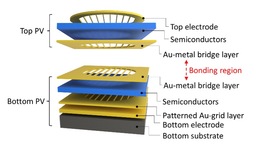Tandem Photovoltaic Cell Structure and Method of Same
TECHNOLOGY NUMBER: 2022-313

OVERVIEW
Tandem photovoltaic (PV) including semiconductors with p- and n-type regions- Bottom and top PVs electrically connected by the gold-to-gold metal bridges
- Creates tandem PV cells with a few microns of semiconductor thin films exhibiting mechanical stability
BACKGROUND
Tandem photovoltaic (PV) devices have top and bottom cells comprised of different materials and bandgaps, for instance semiconductors and silicon. The two materials are electrically connected by insertion of a heavily doped tunnel junction layer between them. One challenge presented when developing tandem PVs is achieving efficient light absorption and management across layers. Additionally, suitable materials must be found with desirable bandgaps and complementary properties for each subcell, specifically those which are stable, durable, and that possess high carrier mobility. These materials must also exhibit thin film growth and show an ability to form a tunnel junction region with heavily doped p- and n-type layers. Semiconductors mostly have different lattice constants, which limit lattice-matched epitaxial growth on a substrate. So, a need exists for improved materials that can be epitaxially grown on a substrate with the goals of enhancing solar energy conversion efficiency and enabling more efficient and sustainable photovoltaic technologies.
INNOVATION
Researchers have developed a tandem photovoltaic (PV) which is capable of including III-V semiconductors, silicon, a cathode electrode, an anode electrode, and a gold-to-gold metal bridge electrode. The semiconductors include p-typed and n-typed regions, and separate bottom and top PV cells can be independently fabricated to form a tandem PV structure. The invention does not require heavy-doped tunnel junctions and a lattice-matched material interface between the bottom and top cells. The bottom and the top PVs are electrically connected by the gold-to-gold metal bridge interconnection, which is positioned between the bottom and the top PV cells. The metal bridge may be formed by a cold-welding compression technique, enabling fabrication of highly efficient tandem thermophotovoltaics with 3D stack of air-bridges. This invention therefore creates tandem PV cells with a few microns of semiconductor thin films exhibiting mechanical stability. This structure is therefore compatible with the development of tandem PVs as well as thermophotovoltaic (TPV) cells.